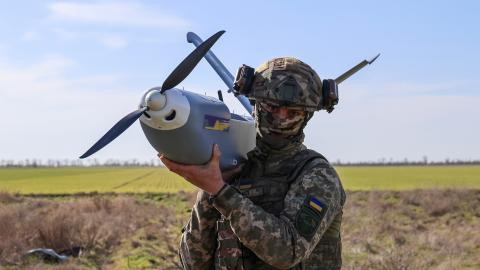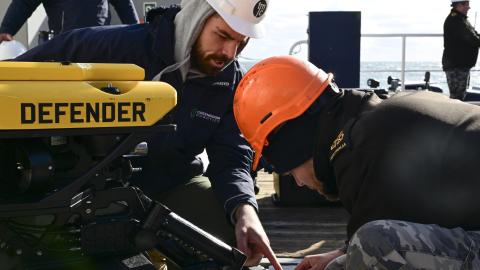In the great-power competition with the United States’ adversaries, none is more formidable than the Chinese Communist Party.
Emboldened by four years of appeasement policies, the CCP is on the march — escalating its military activities, conducting aggressive drills around Taiwan, and increasing its belligerence in the South China Sea. These actions are not isolated incidents, but part of a broader strategy to assert dominance in the region, challenge international norms, and threaten the sovereignty of neighboring countries.
The tension in the Indo-Pacific is nearing a breaking point. Given China’s unholy alliance with Russia, Iran, and North Korea — and America’s friendship with Taiwan and defense treaty with the Philippines — any surge of CCP aggression in the region could catapult the world into a snowballing conflict.
There is one key to avoiding this World War III scenario: deterrence. And as the future of warfare rapidly develops, high-tech supremacy will be the decisive key. That’s why — as President Trump has said — China’s recent DeepSeek challenge to American AI leadership serves as a wake-up call. We must commit greater focus and resources to high-tech supremacy — not only in AI, but in a range of technologies that will define military deterrence in peacetime and determine victory in a time of war.
Unfortunately, the Biden administration largely failed to advance U.S. leadership on the world stage — the high-tech industry being no exception. It held fruitless White House AI summits, failed to push renewal of the National Quantum Initiative signed by President Trump in 2018, responded feebly — when at all — to Chinese and Russian advances in hypersonic weapons and space, and ignored how drones and other uncrewed systems had radically changed the nature of warfare in Ukraine.
In the face of Beijing’s and Moscow’s serial aggressions, these were not just tech policy failures; they were grave national security blunders. Instead of peace through strength, the Biden presidency brought instability and conflict through weakness. But in the midst of its abysmal foreign policy record was one bright spot: a security pact established in 2021 between the United States, Australia, and the United Kingdom, to work together on a cluster of advanced technologies.
AUKUS will change the game when it comes to countering the generational threat posed by China.
The trilateral agreement is composed of two “pillars,” the first of which focuses on the development and sale of conventionally armed, nuclear-powered submarines for the Australian Royal Navy. The crown jewel of the ocean, these submarines will operate with stealth, precision, and endurance to secure the seas.
Pillar 2 establishes collaboration in a host of high-tech areas meant to “enhance our joint capabilities and interoperability.” This pillar will drive the future of modern warfare, covering AI systems and undersea vehicles, cyber capabilities, quantum technologies, hypersonic weapons, and more. If done correctly, it could help the U.S. and our allies obtain the greatest technological advancement since the Manhattan Project, giving us a strategic advantage in the Indo-Pacific.
To ensure the program’s success, Congress passed an initiative, led by one of us (Michael McCaul, chairman emeritus of the House Foreign Affairs Committee), to exempt Australia and the U.K. from lengthy and burdensome licensing requirements. These requirements, while meant to protect our sensitive technology from falling into the wrong hands, also prohibited our trusted allies from using U.S. tech for our collective defense goals.
Congress was explicit: The administration “shall provide” defense articles and technology to these allies, whose export control regimes are similar to our own. But when the Biden administration removed the licensing requirements, it quickly nullified that action by releasing a list of excluded technologies. The list was so lengthy that it swallowed up the exemption. In other words, the Biden administration undermined congressional intent and re-created lengthy burdens for technology sharing with our allies, inexplicably undercutting its one true foreign policy success in the process.
The excluded-technologies list must be immediately trimmed if we want to keep up with China in the technology race that will determine the future balance of power. A March 2023 report from the Australian Strategic Policy Institute indicated that China is ahead of the United States and its allies in 19 of the 23 technologies relevant to AUKUS pillar 2. The Trump administration can close that tech gap, first by trimming the Excluded Technologies List, then by leveraging AUKUS to strengthen key tech areas that will propel the U.S. forward, including but not limited to:
- Artificial intelligence and autonomy, which can be used to improve the speed and precision of decision-making processes and defend against AI-enabled threats. Focus must also be placed on adoption and resilience of autonomous and AI-enabled systems in digital spaces that our adversaries are working to dominate and disrupt.
- Undersea capabilities, with an emphasis on the development of autonomous underwater vehicles (AUVs). That cooperation is already under way thanks to the first AUV prototype, dubbed the Ghost Shark. A joint development of the Royal Australian Navy and an American company, Anduril Industries, this cutting-edge vehicle could operate autonomously, evade sonar detection, collect data, and potentially even release weapons. AI systems like these will perfectly complement the pillar 1 nuclear submarines but will be more agile, far less expensive, and developed more quickly.
- “Generation-after-next quantum capabilities,” ultra-sensitive technology that could be used for an onboard positioning, navigation, and timing (PNT) system, acting as a quantum compass to guide a vessel when GPS is down or under attack. Quantum-driven technology could also be used for stealth sensing of objects by measuring the minute fluctuations in the gravitational field, effectively becoming a quantum sonar that could detect and hunt down Chinese or Russian submarines even in the deepest oceans. Likewise, post-quantum cryptography offers unparalleled security for sending and receiving sensitive military communications and classified information that are hack-proof — making quantum communications a cornerstone of future defense strategies.
In our brave new age of great-power competition, our high-tech posture will be as important as our military force posture; in fact, one will determine the other. Just as in World War II the integration of mass production by commercial companies was the key to victory, so too will integration of advanced technologies like AI, quantum, and autonomous systems be key to deterrence — and to victory if war breaks out.
Except this time, we won’t have to rely on American industry alone for needed breakthroughs and deployments. Instead, we can work with key allies to achieve our most important national security goals — including supremacy at sea — and prevent the next world war from breaking out.
As Ronald Reagan told us, “We know only too well that conflict comes not when the forces of freedom are strong, but when they are weak.” For too long, the forces of freedom have been weak in the face of CCP aggression. AUKUS can change that.
Read the article, co-authored with Michael McCaul, in National Review.














